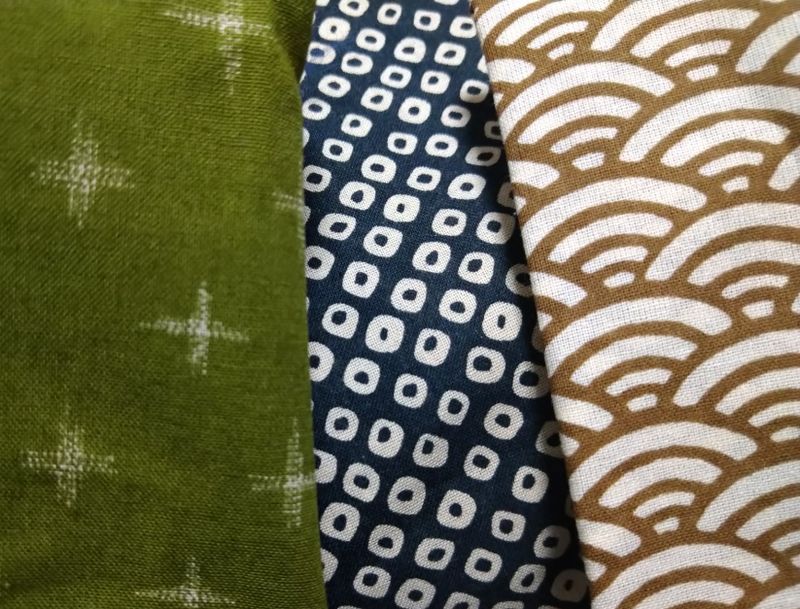Dec 9, 2021
Historical Japanese Cloth Patterns: Igeta, Seigaha, and Kanoko
Partially due to the rise of some recently very popular anime set in somewhat historical time periods, ancient patterns of textiles in Japan have come back into fashion in a way that is more affordable and accessible for the everyday person. On a recent trip to a large 100 yen store, I found several examples of historical fabric prints, labeled as such and available for purchase for only a hundred yen per roughly half of a square meter of fabric. Of course the simple weave cotton broadcloth that the patterns are printed on isn't the highest grade or highest thread count, but the pattern is what is interesting here. Of course, anytime you're in a historical town with a thriving textile community, you may find small packages of kimono scraps available, usually for pretty affordable prices, but I don't think it is surprising to see classical or historical prints on kimono silk. Finding the same kinds of prints on 100 yen store craft merchandise is far more interesting for being less expensive and in my time in Japan it has not been as frequent as of an occurrence.
The more I looked into the history of these designs, the more I realize that I have seen more of them around than I thought possible. This isn't as simple as just a few scraps at the 100 yen store, but even just in that same discount store's crafting section, other historical patterns exist. Whether in cut cloth or cloth tape or origami paper, many different items bear the markings of these historically relevant textiles.
There have been more articulate patterns using a variety of nicer pieces of cloth sold for various purposes at 100 yen stores around the country in the last couple of years since that one show set in the Taisho era premiered and became so popular. I've personally seen everything from washi tape to lens cleaning cloths, pencil boards, and a number of things in between. Of course these historical patterns that are usually not copyrighted despite the popularity of similar patterns on that program. This has made traditional patterns a great opportunity for income on the part of the 100 yen store market, always looking to make the most of a popular trends with the least amount of effort.
While finding cute cloth at the hundred in store with semi-historical patterns isn't necessarily a new adventure for anyone who has been looking for these products in the last two years, these patterns weren't ones are recognized necessarily from the show.

The first pattern that I really went for was the one that looks a little bit like a plus sign or hashtag. It is called igeta and it turns out this is intended to mimic a well and provide the wearer with the same kind of prosperity that having a well with bring. The more recognizable variation of the pattern involves more space between the slashes, creating a more hashtag or pound sign ( # ) appearance, but the one I found at the 100 yen store was closed off into a little pluses. I still thought it looked interesting and picked it up. Later, I found out many more things about the special design. The name also applies to the name of the fancy green tea shop in Sendai whose logo involves this character. It is included in many historical Japanese family symbols as well.
The historical pattern situation doesn't stop there. The two other fabric selections that I had picked out from the same 100 yen store hold their own special stories and values. The one that I have in brown is known as seigaiha or blue ocean waves and I've used it before in the sashiko post. It's a very common pattern in crafts like sashiko. It might be someone's lunch bag or handkerchief or some craft goods at a local market, but this pattern shows up in a lot of places especially anywhere near the sea. The print being in brown is a bit weird and might be why it was still available at the 100 yen store. Usually this print shows up in some shade of blue on white.
The other cloth that I picked up has a pattern of squares with concentric squares in white and whatever color the overall color is, usually purple for some reason. This pattern is known as shibori or kanoko or fawn and is usually considered expensive because the traditional method for making it involves a lot of intricate hand dying of the fabric. I am sure this fabric did not go through such rigorous processes just to be sold as broad cloth at the price of less than 100 yen for about half a meter. That said, it's still a lovely pattern and the spots are supposed to resemble the spots on the back of a fawn.
If you want more information on these and other patterns here is some great resources that I found while trying to research this piece: Kirikomade, Olaf Olsson, and Kimurakami.



0 Comments